NU416 Nursing Assignment: Alex's Home Care and Hospitalization
VerifiedAdded on 2023/06/03
|5
|951
|433
Homework Assignment
AI Summary
This nursing assignment focuses on determining the home care resources needed to promote Alex's health and minimize hospitalizations. It emphasizes the importance of accessible, comprehensive, and family-centered care. The assignment identifies various interventions, including patient education, increased follow-up activities, and home health care services, to reduce hospital visits. It also outlines the inter-professional care team members, such as nurse specialists, dietitians, and parents, who contribute to managing Alex's chronic illness. Furthermore, the assignment highlights evidence-based therapeutic communication strategies for Alex, his parents, and the care team, such as using silence, giving recognition, and active listening to foster effective communication and support.
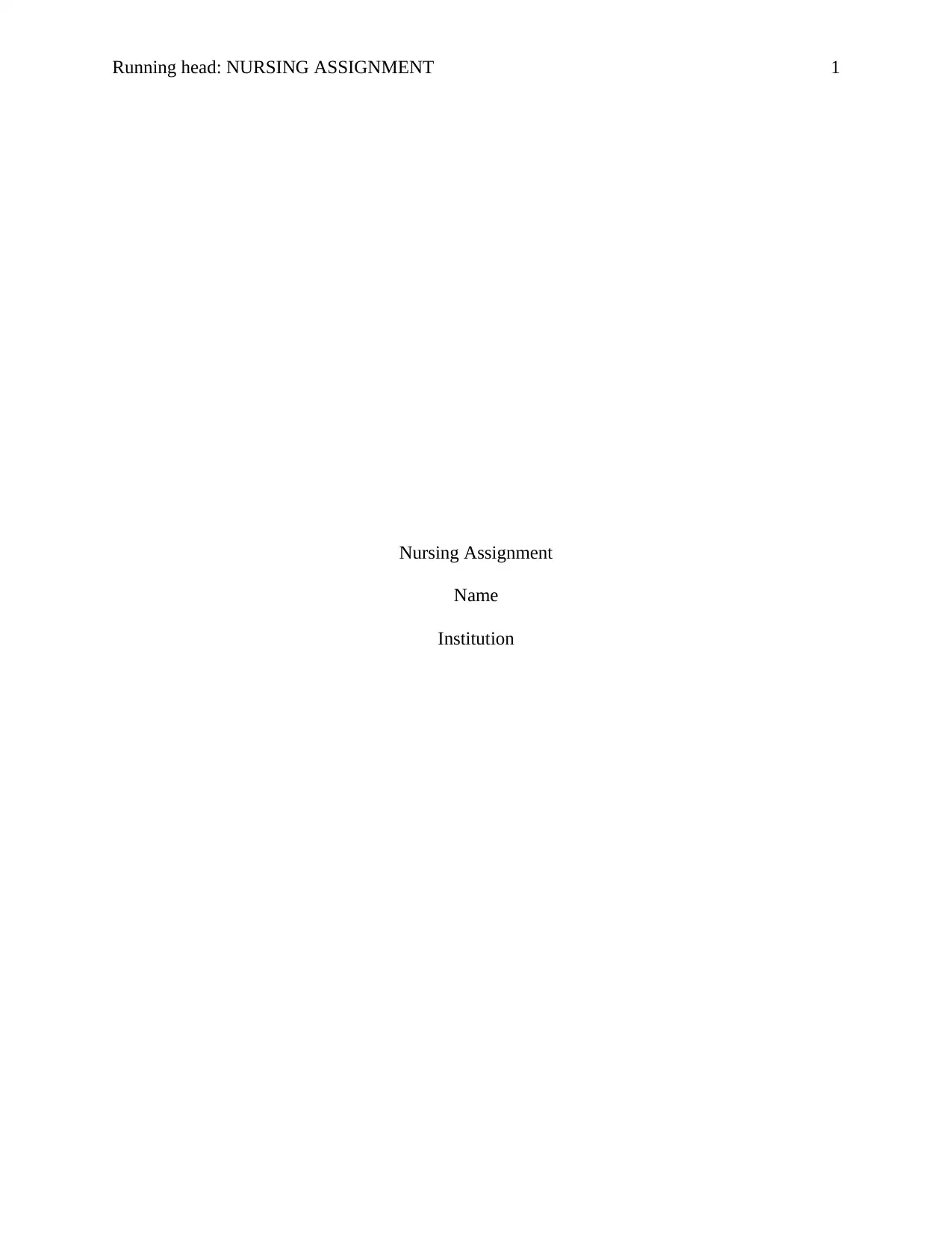
Running head: NURSING ASSIGNMENT 1
Nursing Assignment
Name
Institution
Nursing Assignment
Name
Institution
Paraphrase This Document
Need a fresh take? Get an instant paraphrase of this document with our AI Paraphraser
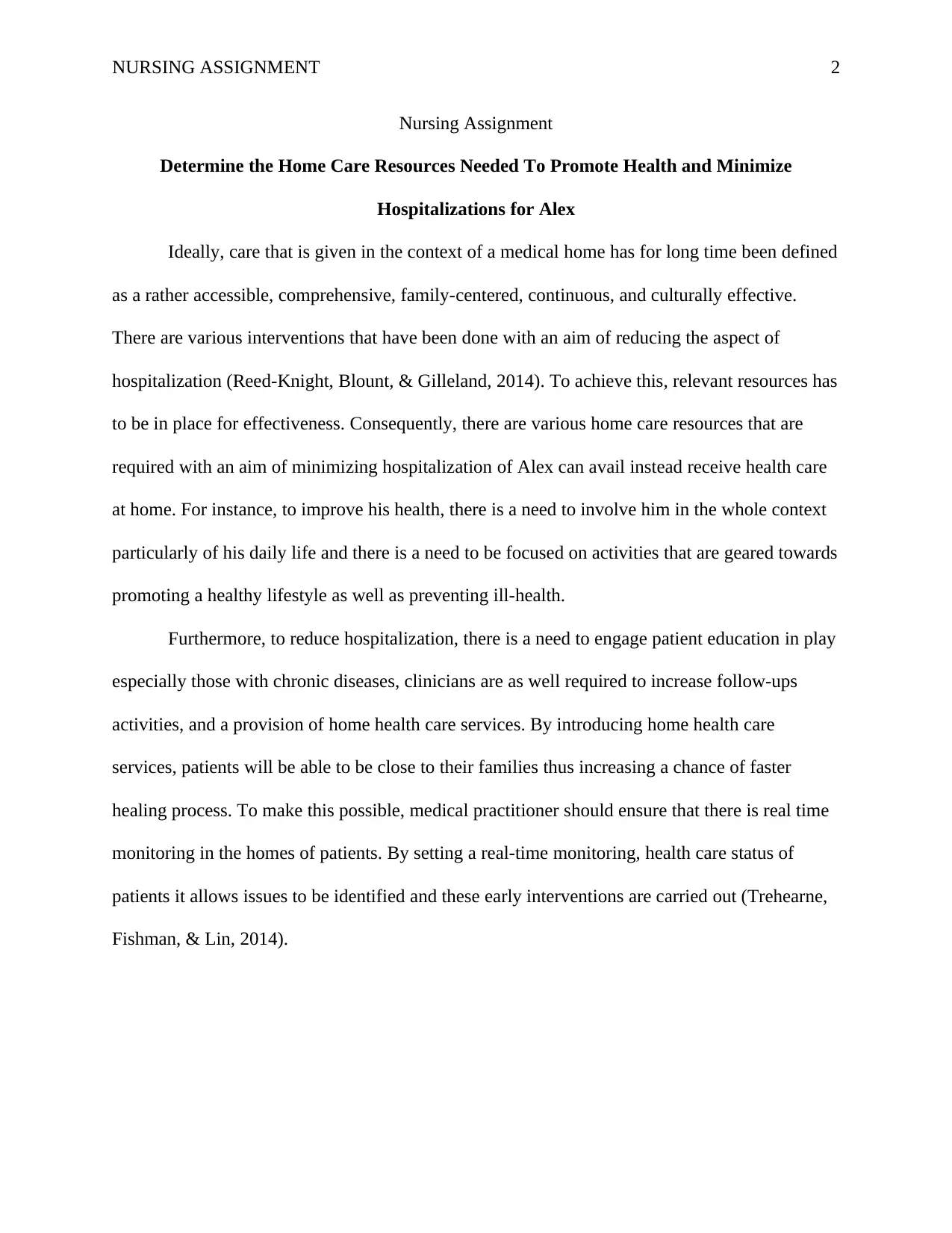
NURSING ASSIGNMENT 2
Nursing Assignment
Determine the Home Care Resources Needed To Promote Health and Minimize
Hospitalizations for Alex
Ideally, care that is given in the context of a medical home has for long time been defined
as a rather accessible, comprehensive, family-centered, continuous, and culturally effective.
There are various interventions that have been done with an aim of reducing the aspect of
hospitalization (Reed-Knight, Blount, & Gilleland, 2014). To achieve this, relevant resources has
to be in place for effectiveness. Consequently, there are various home care resources that are
required with an aim of minimizing hospitalization of Alex can avail instead receive health care
at home. For instance, to improve his health, there is a need to involve him in the whole context
particularly of his daily life and there is a need to be focused on activities that are geared towards
promoting a healthy lifestyle as well as preventing ill-health.
Furthermore, to reduce hospitalization, there is a need to engage patient education in play
especially those with chronic diseases, clinicians are as well required to increase follow-ups
activities, and a provision of home health care services. By introducing home health care
services, patients will be able to be close to their families thus increasing a chance of faster
healing process. To make this possible, medical practitioner should ensure that there is real time
monitoring in the homes of patients. By setting a real-time monitoring, health care status of
patients it allows issues to be identified and these early interventions are carried out (Trehearne,
Fishman, & Lin, 2014).
Nursing Assignment
Determine the Home Care Resources Needed To Promote Health and Minimize
Hospitalizations for Alex
Ideally, care that is given in the context of a medical home has for long time been defined
as a rather accessible, comprehensive, family-centered, continuous, and culturally effective.
There are various interventions that have been done with an aim of reducing the aspect of
hospitalization (Reed-Knight, Blount, & Gilleland, 2014). To achieve this, relevant resources has
to be in place for effectiveness. Consequently, there are various home care resources that are
required with an aim of minimizing hospitalization of Alex can avail instead receive health care
at home. For instance, to improve his health, there is a need to involve him in the whole context
particularly of his daily life and there is a need to be focused on activities that are geared towards
promoting a healthy lifestyle as well as preventing ill-health.
Furthermore, to reduce hospitalization, there is a need to engage patient education in play
especially those with chronic diseases, clinicians are as well required to increase follow-ups
activities, and a provision of home health care services. By introducing home health care
services, patients will be able to be close to their families thus increasing a chance of faster
healing process. To make this possible, medical practitioner should ensure that there is real time
monitoring in the homes of patients. By setting a real-time monitoring, health care status of
patients it allows issues to be identified and these early interventions are carried out (Trehearne,
Fishman, & Lin, 2014).
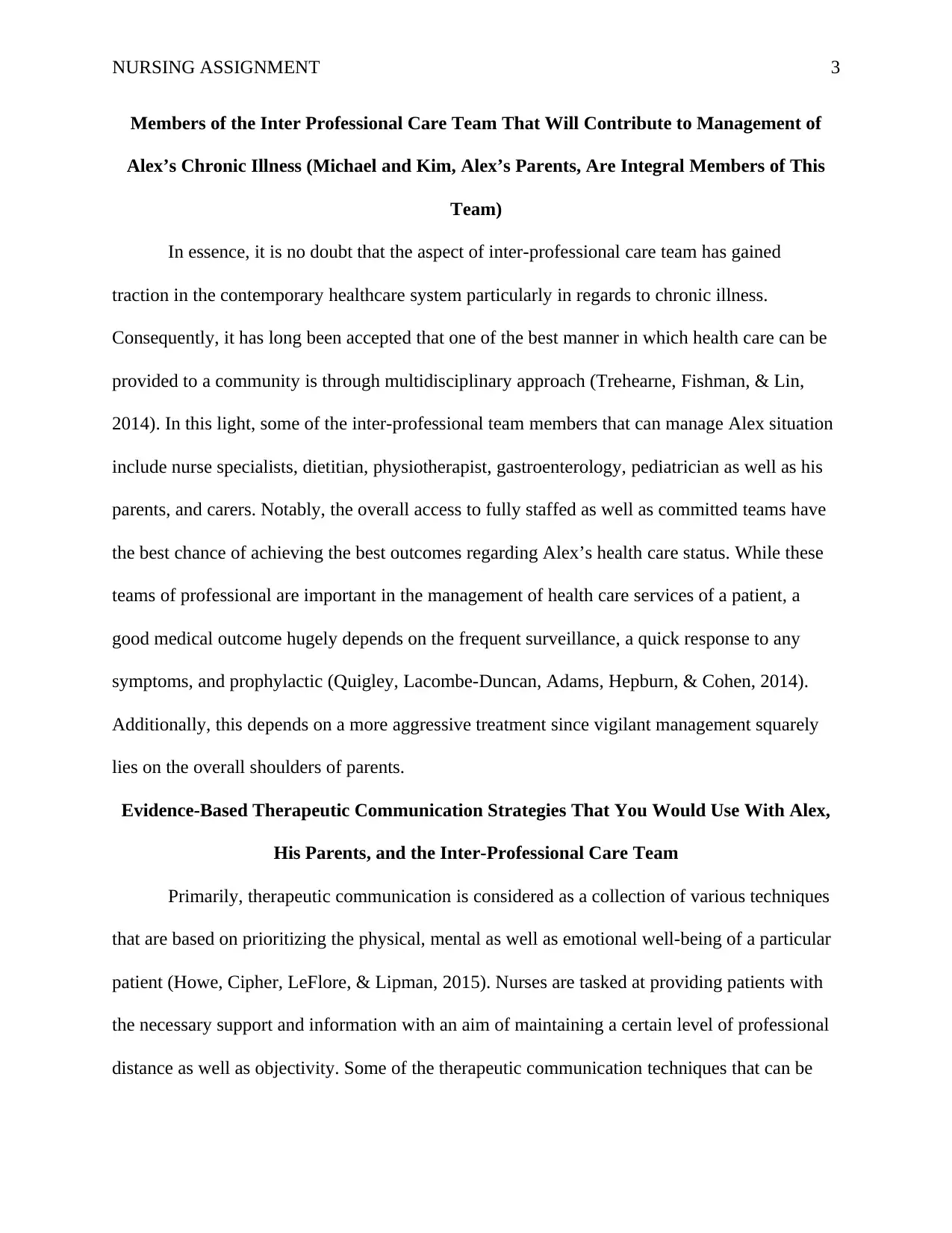
NURSING ASSIGNMENT 3
Members of the Inter Professional Care Team That Will Contribute to Management of
Alex’s Chronic Illness (Michael and Kim, Alex’s Parents, Are Integral Members of This
Team)
In essence, it is no doubt that the aspect of inter-professional care team has gained
traction in the contemporary healthcare system particularly in regards to chronic illness.
Consequently, it has long been accepted that one of the best manner in which health care can be
provided to a community is through multidisciplinary approach (Trehearne, Fishman, & Lin,
2014). In this light, some of the inter-professional team members that can manage Alex situation
include nurse specialists, dietitian, physiotherapist, gastroenterology, pediatrician as well as his
parents, and carers. Notably, the overall access to fully staffed as well as committed teams have
the best chance of achieving the best outcomes regarding Alex’s health care status. While these
teams of professional are important in the management of health care services of a patient, a
good medical outcome hugely depends on the frequent surveillance, a quick response to any
symptoms, and prophylactic (Quigley, Lacombe-Duncan, Adams, Hepburn, & Cohen, 2014).
Additionally, this depends on a more aggressive treatment since vigilant management squarely
lies on the overall shoulders of parents.
Evidence-Based Therapeutic Communication Strategies That You Would Use With Alex,
His Parents, and the Inter-Professional Care Team
Primarily, therapeutic communication is considered as a collection of various techniques
that are based on prioritizing the physical, mental as well as emotional well-being of a particular
patient (Howe, Cipher, LeFlore, & Lipman, 2015). Nurses are tasked at providing patients with
the necessary support and information with an aim of maintaining a certain level of professional
distance as well as objectivity. Some of the therapeutic communication techniques that can be
Members of the Inter Professional Care Team That Will Contribute to Management of
Alex’s Chronic Illness (Michael and Kim, Alex’s Parents, Are Integral Members of This
Team)
In essence, it is no doubt that the aspect of inter-professional care team has gained
traction in the contemporary healthcare system particularly in regards to chronic illness.
Consequently, it has long been accepted that one of the best manner in which health care can be
provided to a community is through multidisciplinary approach (Trehearne, Fishman, & Lin,
2014). In this light, some of the inter-professional team members that can manage Alex situation
include nurse specialists, dietitian, physiotherapist, gastroenterology, pediatrician as well as his
parents, and carers. Notably, the overall access to fully staffed as well as committed teams have
the best chance of achieving the best outcomes regarding Alex’s health care status. While these
teams of professional are important in the management of health care services of a patient, a
good medical outcome hugely depends on the frequent surveillance, a quick response to any
symptoms, and prophylactic (Quigley, Lacombe-Duncan, Adams, Hepburn, & Cohen, 2014).
Additionally, this depends on a more aggressive treatment since vigilant management squarely
lies on the overall shoulders of parents.
Evidence-Based Therapeutic Communication Strategies That You Would Use With Alex,
His Parents, and the Inter-Professional Care Team
Primarily, therapeutic communication is considered as a collection of various techniques
that are based on prioritizing the physical, mental as well as emotional well-being of a particular
patient (Howe, Cipher, LeFlore, & Lipman, 2015). Nurses are tasked at providing patients with
the necessary support and information with an aim of maintaining a certain level of professional
distance as well as objectivity. Some of the therapeutic communication techniques that can be
⊘ This is a preview!⊘
Do you want full access?
Subscribe today to unlock all pages.

Trusted by 1+ million students worldwide
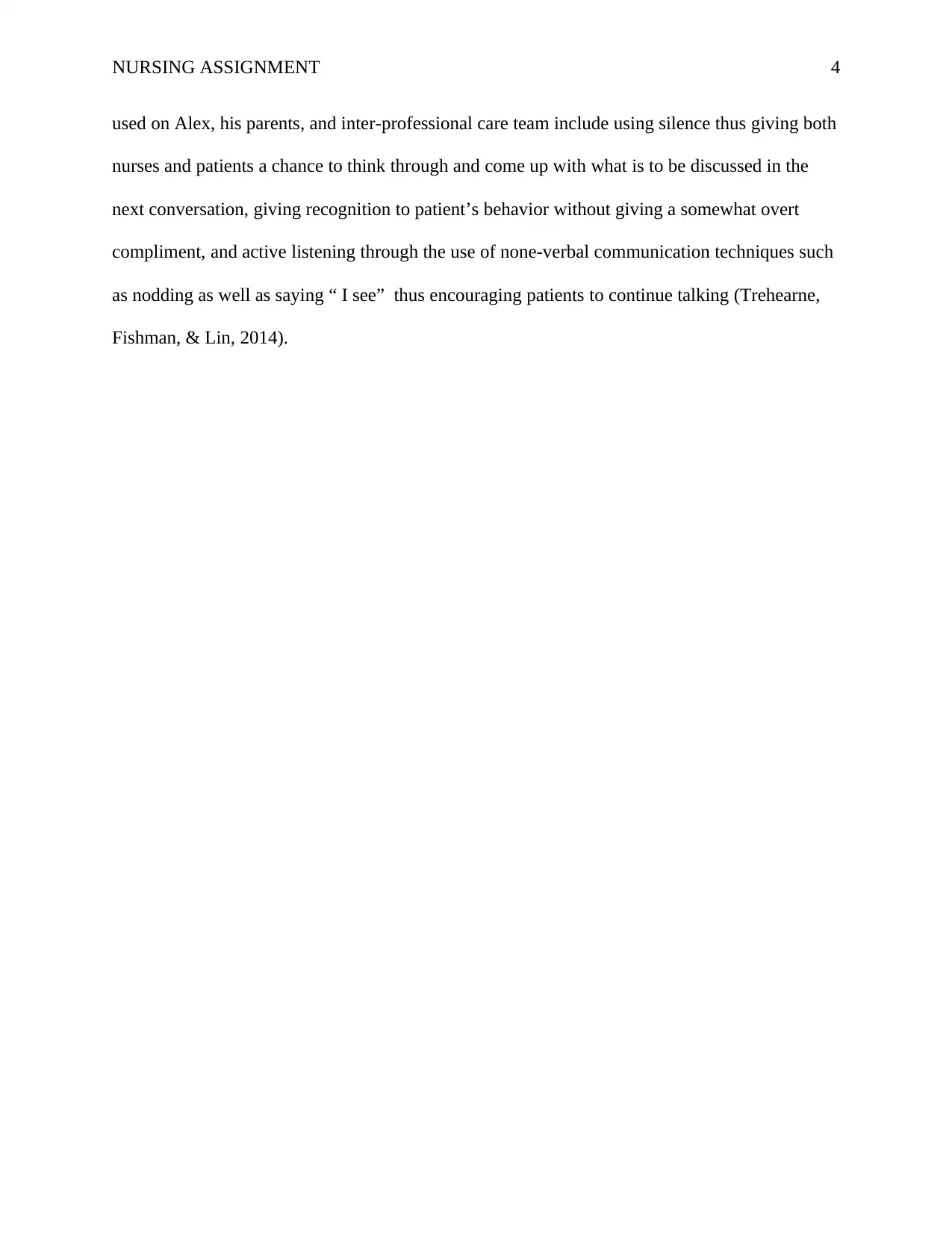
NURSING ASSIGNMENT 4
used on Alex, his parents, and inter-professional care team include using silence thus giving both
nurses and patients a chance to think through and come up with what is to be discussed in the
next conversation, giving recognition to patient’s behavior without giving a somewhat overt
compliment, and active listening through the use of none-verbal communication techniques such
as nodding as well as saying “ I see” thus encouraging patients to continue talking (Trehearne,
Fishman, & Lin, 2014).
used on Alex, his parents, and inter-professional care team include using silence thus giving both
nurses and patients a chance to think through and come up with what is to be discussed in the
next conversation, giving recognition to patient’s behavior without giving a somewhat overt
compliment, and active listening through the use of none-verbal communication techniques such
as nodding as well as saying “ I see” thus encouraging patients to continue talking (Trehearne,
Fishman, & Lin, 2014).
Paraphrase This Document
Need a fresh take? Get an instant paraphrase of this document with our AI Paraphraser
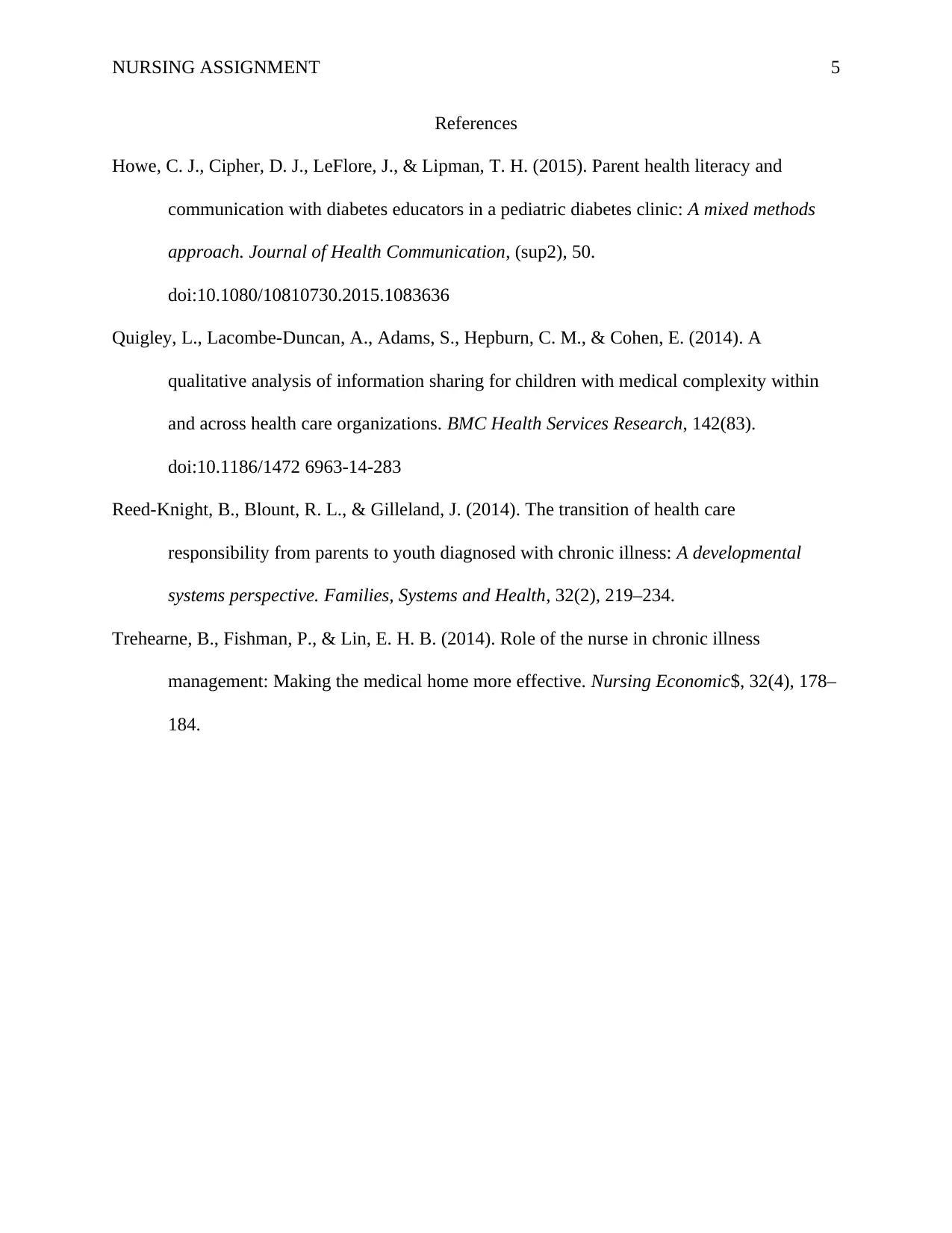
NURSING ASSIGNMENT 5
References
Howe, C. J., Cipher, D. J., LeFlore, J., & Lipman, T. H. (2015). Parent health literacy and
communication with diabetes educators in a pediatric diabetes clinic: A mixed methods
approach. Journal of Health Communication, (sup2), 50.
doi:10.1080/10810730.2015.1083636
Quigley, L., Lacombe-Duncan, A., Adams, S., Hepburn, C. M., & Cohen, E. (2014). A
qualitative analysis of information sharing for children with medical complexity within
and across health care organizations. BMC Health Services Research, 142(83).
doi:10.1186/1472 6963-14-283
Reed-Knight, B., Blount, R. L., & Gilleland, J. (2014). The transition of health care
responsibility from parents to youth diagnosed with chronic illness: A developmental
systems perspective. Families, Systems and Health, 32(2), 219–234.
Trehearne, B., Fishman, P., & Lin, E. H. B. (2014). Role of the nurse in chronic illness
management: Making the medical home more effective. Nursing Economic$, 32(4), 178–
184.
References
Howe, C. J., Cipher, D. J., LeFlore, J., & Lipman, T. H. (2015). Parent health literacy and
communication with diabetes educators in a pediatric diabetes clinic: A mixed methods
approach. Journal of Health Communication, (sup2), 50.
doi:10.1080/10810730.2015.1083636
Quigley, L., Lacombe-Duncan, A., Adams, S., Hepburn, C. M., & Cohen, E. (2014). A
qualitative analysis of information sharing for children with medical complexity within
and across health care organizations. BMC Health Services Research, 142(83).
doi:10.1186/1472 6963-14-283
Reed-Knight, B., Blount, R. L., & Gilleland, J. (2014). The transition of health care
responsibility from parents to youth diagnosed with chronic illness: A developmental
systems perspective. Families, Systems and Health, 32(2), 219–234.
Trehearne, B., Fishman, P., & Lin, E. H. B. (2014). Role of the nurse in chronic illness
management: Making the medical home more effective. Nursing Economic$, 32(4), 178–
184.
1 out of 5
Related Documents
Your All-in-One AI-Powered Toolkit for Academic Success.
+13062052269
info@desklib.com
Available 24*7 on WhatsApp / Email
![[object Object]](/_next/static/media/star-bottom.7253800d.svg)
Unlock your academic potential
Copyright © 2020–2025 A2Z Services. All Rights Reserved. Developed and managed by ZUCOL.





